Addressing CPU Bottleneck Issues: Strategies Without Relying on Turbo Boost
Experiencing performance issues while gaming or running intensive applications can be frustrating, especially when hardware configurations lead to bottlenecks. Recently, I installed The Finals and observed significant framerate instability. The only apparent solution was enabling Turbo Boost, which temporarily improved performance. However, this solution comes with its own drawbacks—mainly increased heat and thermal throttling on my laptop, ultimately impacting the overall experience.
If you’re in a similar situation and seeking alternatives to Turbo Boost to mitigate CPU bottlenecks, this article offers some key strategies and insights to optimize your system’s performance without compromising temperature management.
Understanding CPU Bottlenecking
A CPU bottleneck occurs when your processor limits the overall performance of your system while trying to handle demanding tasks or games. This imbalance can cause low frame rates, stuttering, and inconsistent performance, detracting from your user experience.
Turbo Boost is Intel’s technology that temporarily increases the processor’s clock speed to handle demanding workloads. While effective, relying solely on this feature may lead to overheating and thermal throttling, especially on laptops with limited cooling capabilities.
Alternative Strategies to Mitigate CPU Bottlenecking
-
Optimize In-Game Settings
-
Lower graphics requirements such as resolution, texture detail, and shadow quality to reduce CPU load.
-
Use lower settings selectively for CPU-intensive effects rather than GPU-centric options.
-
Adjust System Power and Performance Settings
-
Set your system’s power plan to ‘Balanced’ or ‘Power Saver’ rather than ‘High Performance’.
-
Disable or limit background processes that compete for CPU resources.
-
Update Drivers and BIOS
-
Ensure your CPU chipset drivers, graphics drivers, and BIOS are up to date to benefit from performance improvements and bug fixes.
-
Use Task Manager and Resource Monitoring
-
Identify processes consuming excessive CPU resources.
-
Terminate unnecessary background tasks to free up CPU cycles.
-
Maintain Proper Cooling and Ventilation
-
Regularly clean your laptop vents and fans.
-
Use cooling pads to assist in maintaining optimal temperatures during intensive use.
-
Enable CPU Affinity and Prioritization
-
Use system tools to assign specific CPU cores to certain applications, reducing contention.
-
Consider Hardware Upgrades
-
If possible, upgrade to a workstation or gaming laptop with better cooling solutions and more powerful CPUs.
Share this content:



